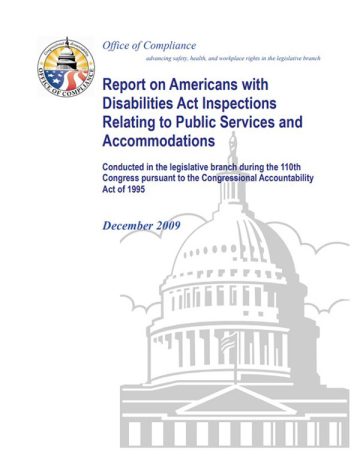INTRODUCTION
The Congressional Accountability Act of 1995 (CAA), 2 U.S.C. § 1301, et seq., applies the Americans with Disabilities Act (ADA) to the legislative branch. Under the CAA, the Office of Compliance (OOC), an independent legislative branch agency, enforces the ADA. 2 U.S.C. §§ 1311 & 1331. Title I of the ADA, prohibiting employment discrimination because of disability, is enforced through the OOC’s counseling, mediation and hearing procedure. See, CAA, 2 U.S.C. §§ 1401-1406.
The OOC’s General Counsel enforces Titles II and III of the ADA, providing for access to public services and accommodations by individuals with disabilities. See CAA, 2 U.S.C. § 1331. The General Counsel conducts biennial inspections of the legislative branch to ascertain compliance with the ADA and reports his findings to Congress. 2 U.S.C. § 1331(f)(1). This Report to Congress, and to the entities responsible for correcting violations, presents the findings of the inspection conducted during the 110th Congress.
SUMMARY
Persons with disabilities are guaranteed access to the public services and accommodations provided by the legislative branch. This right to access includes access to the buildings and facilities where these services and accommodations are provided and access to the representatives, committees, and staff who provide these services and accommodations. Under the ADA, the right to access also includes the right to be included in the evacuation procedures for legislative buildings and facilities. During the 110th Congress, planning for the prompt evacuation of individuals with mobility impairments and providing appropriate signage were priorities. In all public buildings on Capitol Hill, employees and visitors with mobility impairments will now be directed to designated staging areas during an emergency. From these staging areas, individuals with mobility impairments will be guided to safety by trained employees.
Further, while additional work needs to be done, steady progress has been made installing visual alarms in public areas and providing hallway signage with egress information in braille. These changes will assure prompt notification and evacuation of employees and visitors with vision and hearing impairments.

